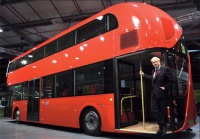Urban legend: Hybrid bus technology
London’s iconic red buses are going green, but it is yet to be seen which technology will drive the change

Tradition and technology are being brought together in London as the city’s iconic red buses receive a green makeover. But the type of systems that will drive this change are yet to be determined and the options are causing division among the UK’s engineering community.
Earlier this month, mayor Boris Johnson unveiled a life-size mock-up of the famous open-backed Routemaster bus at the London Transport Museum. The bus is expected to be on London’s streets during the Olympics as part of a wider plan to roll out 300 hybrid buses in London by 2012. At the moment, almost all of Transport for London’s (TFL’s) buses are powered by diesel engines, with the exception of 56 buses that use hybrid propulsion systems.
The hybrid fleet was a trial launched in 2006 when a number of manufacturers were brought in to test the suitability of different hybrid drivetrains in the urban environment. The options were split into two categories: a parallel hybrid, where the bus is driven by the battery or directly by the engine, or a series hybrid system, where there is no direct link between the engine and wheels, with the bus driven solely by battery power.
Register now to continue reading
Thanks for visiting The Engineer. You’ve now reached your monthly limit of premium content. Register for free to unlock unlimited access to all of our premium content, as well as the latest technology news, industry opinion and special reports.
Benefits of registering
-
In-depth insights and coverage of key emerging trends
-
Unrestricted access to special reports throughout the year
-
Daily technology news delivered straight to your inbox










Water Sector Talent Exodus Could Cripple The Sector
Maybe if things are essential for the running of a country and we want to pay a fair price we should be running these utilities on a not for profit...